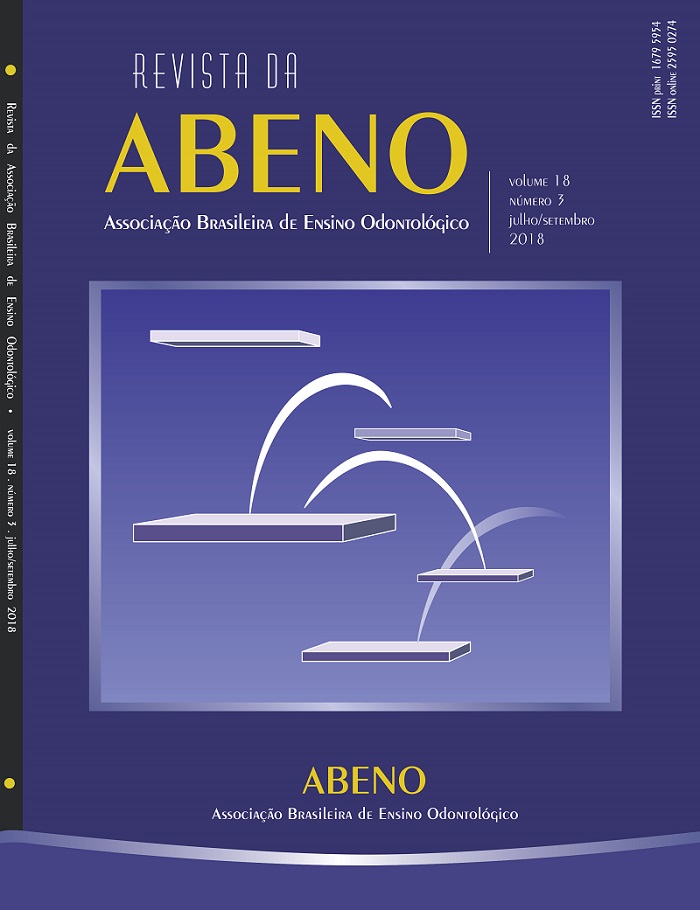The use of digital resources in the teaching of Dental Radiology: an integrative literature review
DOI:
https://doi.org/10.30979/rev.abeno.v18i3.497Keywords:
Computer-assisted Instruction. Educational Technology. Dentistry. Radiology.Abstract
In dentistry, several resources have been adopted as strategies to aid the teaching-learning process in order to integrate theory and practice. This study aims to raise the main digital educational resources in the area of Dental Radiology and discuss the learning characteristics of these resources, according to the Kirkpatrick model. An integrative review of papers published between 2007 and 2017 was carried out in the databases PubMed, Virtual Health Library and Brazilian Digital Library of Theses and Dissertations, considering the descriptors: "computer-assisted instruction"; dental education"; "educational technology"; "radiology". The final sample consisted of 13 articles that met the inclusion and exclusion criteria, in which the following digital educational resources were identified: 03 interactive module based on the Web; 03 digital learning objects; 02 virtual platform courses; 02 interactive digital tools; 01 3D visualization software; 01 simulator in oral radiology and 01 technological system of response to the student. From the adopted learning model, the following levels were identified in the study: participants' satisfaction and / or gain of knowledge of the participants before or after an intervention or both. The present literature review identified 7 types of digital educational resources used in oral radiology, which presented positive attitudes of students in relation to e-learning in all studies, in addition to a significant gain in knowledge in most of the studies.Downloads
References
Ramesh A, Ganguly R. Interactive learning in oral and maxillofacial radiology. Imaging Sci Dent. 2016;46:211-6.
Mattheos N, Stefanovic N, Apse P, Attstrom R, Buchanan J, Brown P, et al. Potential of information technology in dental education. Eur J Dent Educ. 2008;12:85-91.
Santos GNM, Leite AF, Figueiredo PT de S, Pimentel NM, Flores-Mir C, de Melo NS, et al. Effectiveness of e-learning in oral radiology education: a systematic review. J Dent Educ. 2016;80:1126-39.
Costa E. Método de ensino-aprendizagem no diagnóstico radiográfico das anormalidades ósseas dos maxilares [tese] Florianópolis: Faculdade de Engenharia e Gestão do Conhecimento. Universidade Federal de Santa Catarina; 2012.
Chang H-J, Symkhampha K, Huh K-H, Yi W-J, Heo M-S, Lee S-S, et al. The development of a learning management system for dental radiology education: A technical report. Imaging Sci Dent. 2017;47:51-55.
Meckfessel S, Stühmer C, Bormann KH, Kupka T, Behrends M, Matthies H, et al. Introduction of e-learning in dental radiology reveals significantly improved results in final examination. J Cranio-Maxillofacial Surg. 2011;39:40-8.
Vuchkova J, Maybury T, Farah CS. Digital interactive learning of oral radiographic anatomy. Eur J Dent Educ. 2012;16:79-87.
Maloney S, Haas R, Keating JL, Molloy E, Jolly B, Sims J, et al. Effectiveness of Web-based versus face-to-face delivery of education in prescription of falls-prevention exercise to health professionals: randomized trial. J Med Internet Res. 2011;13(4):e116. DOI:
2196/jmir.1680.
Mendes KDS, Silveira RC de CP, Galvão CM. Revisão integrativa: método de pesquisa para a incorporação de evidências na saúde e na enfermagem. Texto & Contexto Enferm.2008;17:758-64.
Busanello FH, da Silveira PF, Liedke GS Arús NA, Vizzotto MB, Silveira HE, et al. Evaluation of a digital learning object (DLO) to support the learning process in radiographic dental diagnosis. Eur J Dent Educ. 2015;19:222-8.
Kavadella A, Tsiklakis K, Vougiouklakis G, Lionarakis A. Evaluation of a blended learning course for teaching oral radiology to undergraduate dental students. Eur J Dent Educ. 2012;16:88-95.
Nilsson TA, Hedman LR, Ahlqvist JB. Dental student skill retention eight months after simulator-supported training in oral radiology. J Dent Educ. 2011;75:679-84.
Tan P, Hay DB, Whaites E. Science Course in Dental Education: A Short-Term Longitudinal Study. J Dent Educ. 2009;73:1202-12.
Silveira HLD, Gomes MJ, Silveira HED, Dalla-Bona RR. Evaluation of the radiographic cephalometry learning process by a learning virtual object. Am J Orthod Dentofac Orthop. 2009;136:134-8.
Cruz AD, Costa JJ, Almeida SM. Distance learning in dental radiology: immediate impact of the implementation. Brazilian Dent Sci. 2014;17:90-97.
Arús NA. Desenvolvimento e teste de um objeto digital de aprendizagem para interpretação das imagens por ressonância magnética da articulação tem-poromandibular [tese]. Porto Alegre: Faculdade de Odontologia, Universidade Federal do Rio Grande do Sul; 2012.
Vuchkova J, Maybury TS, Farah CS. Testing the educational potential of 3D visualization software in oral radiographic interpretation. J Dent Educ. 2011;75:1417-25. R
Wu M, Zhang X, Koenig L, Lynch J, Wirtz T, Mao E, et al. Web-based training method for interpretation of dental images. J Digit Imaging. 2010;23:493-500.
Pahinis K, Stokes CW, Walsh TF, Cannavina G. Evaluating a blended-learning course taught to different groups of learners in a dental school. J Dent Educ. 2007;71:269-78.
Salajan, F., Mount G. University of Toronto’s dental school shows “new teeth”: moving towards online instruction. J Dent Educ. 2008;72:532-42.
Al-jewair TS, Azarpazhooh A, Suri S, Shah PS. Computer-Assisted Learning in Orthodontic Education: A Systematic Review and Meta-Analysis. J Dent Educ. 2009;73:730-9.
Al-Jewair TS, Qutub AF, Malkhassian G, Dempster LJ. A systematic review of computer-assisted learning in endodontics education. J Dent Educ. 2010;74:601-11.
Schleyer TK, Johnson LA. Evaluation of educational software. J Dent Educ. 2003;67:1221-8.
Downloads
Published
How to Cite
Issue
Section
License
Autores que publicam nesta revista concordam com os seguintes termos:
a) Autores mantém os direitos autorais e concedem à revista o direito de primeira publicação, com o trabalho simultaneamente licenciado sob a Licença Creative Commons Attribution que permite o compartilhamento do trabalho com reconhecimento da autoria e publicação inicial nesta revista.
b) Autores têm autorização para assumir contratos adicionais separadamente, para distribuição não-exclusiva da versão do trabalho publicada nesta revista (ex.: publicar em repositório institucional ou como capítulo de livro), com reconhecimento de autoria e publicação inicial nesta revista.
c) Autores têm permissão e são estimulados a publicar e distribuir seu trabalho online (ex.: em repositórios institucionais ou na sua página pessoal) a qualquer ponto antes ou durante o processo editorial, já que isso pode gerar alterações produtivas, bem como aumentar o impacto e a citação do trabalho publicado (Veja O Efeito do Acesso Livre).






